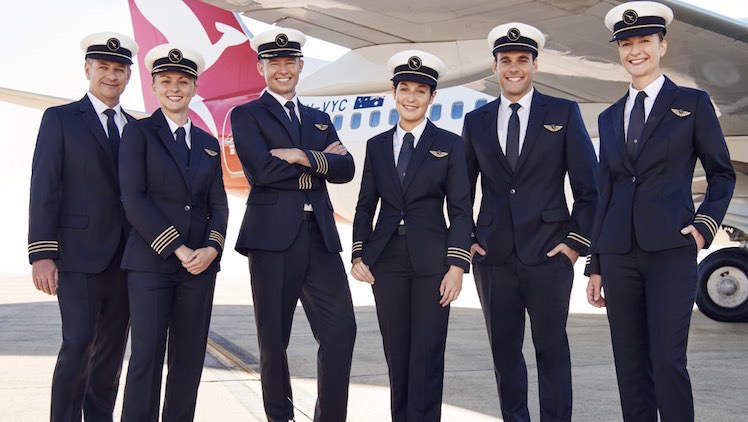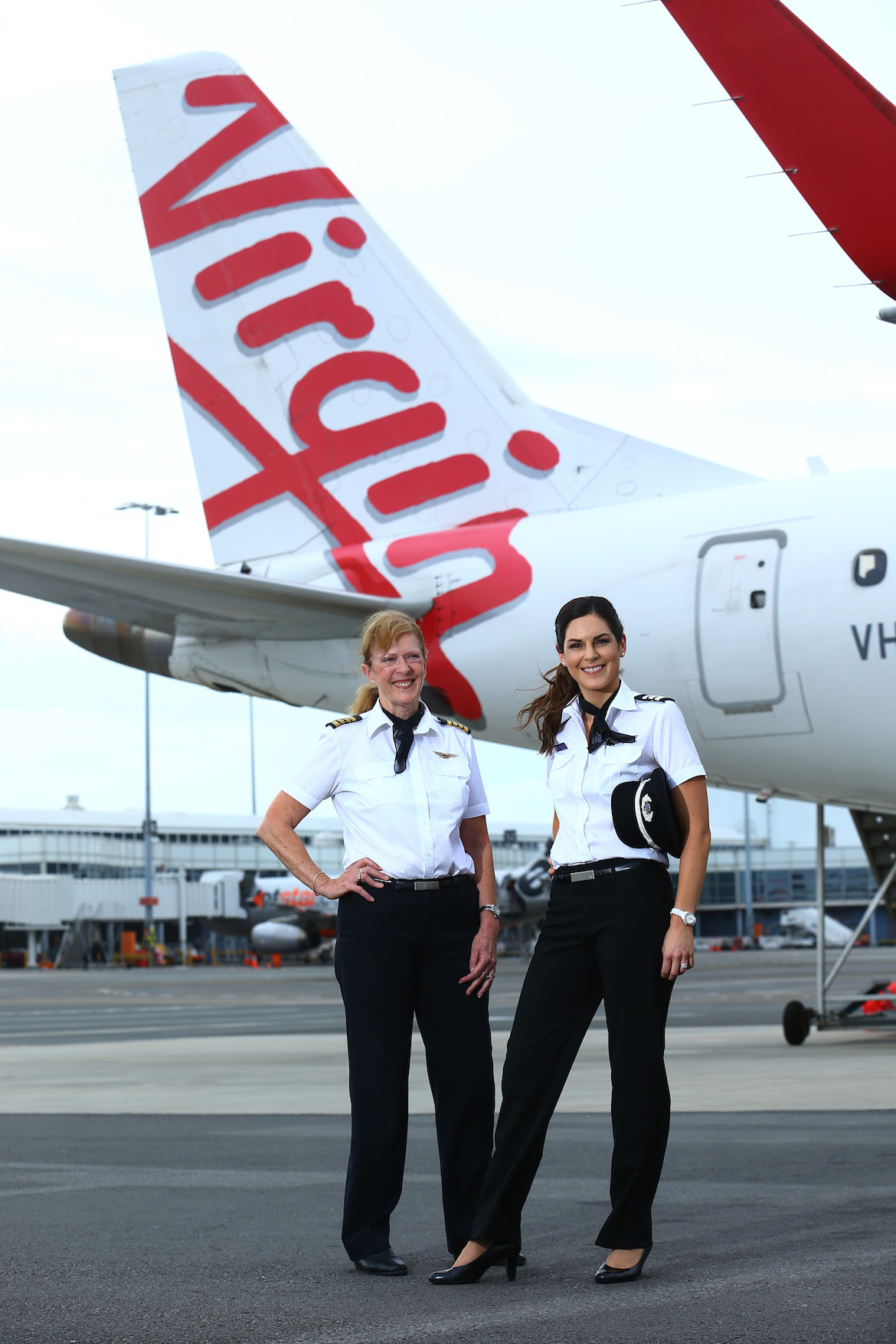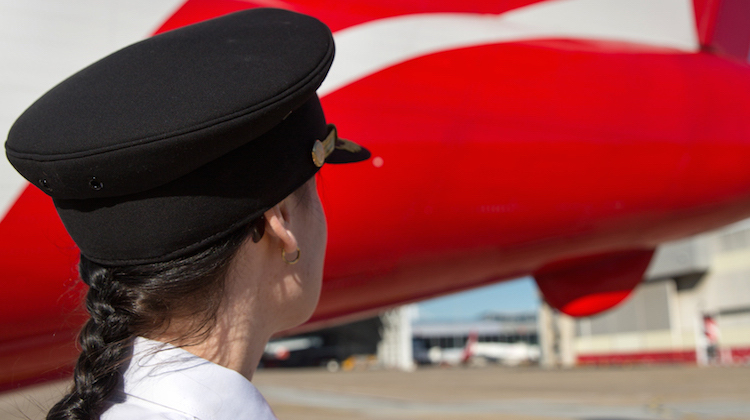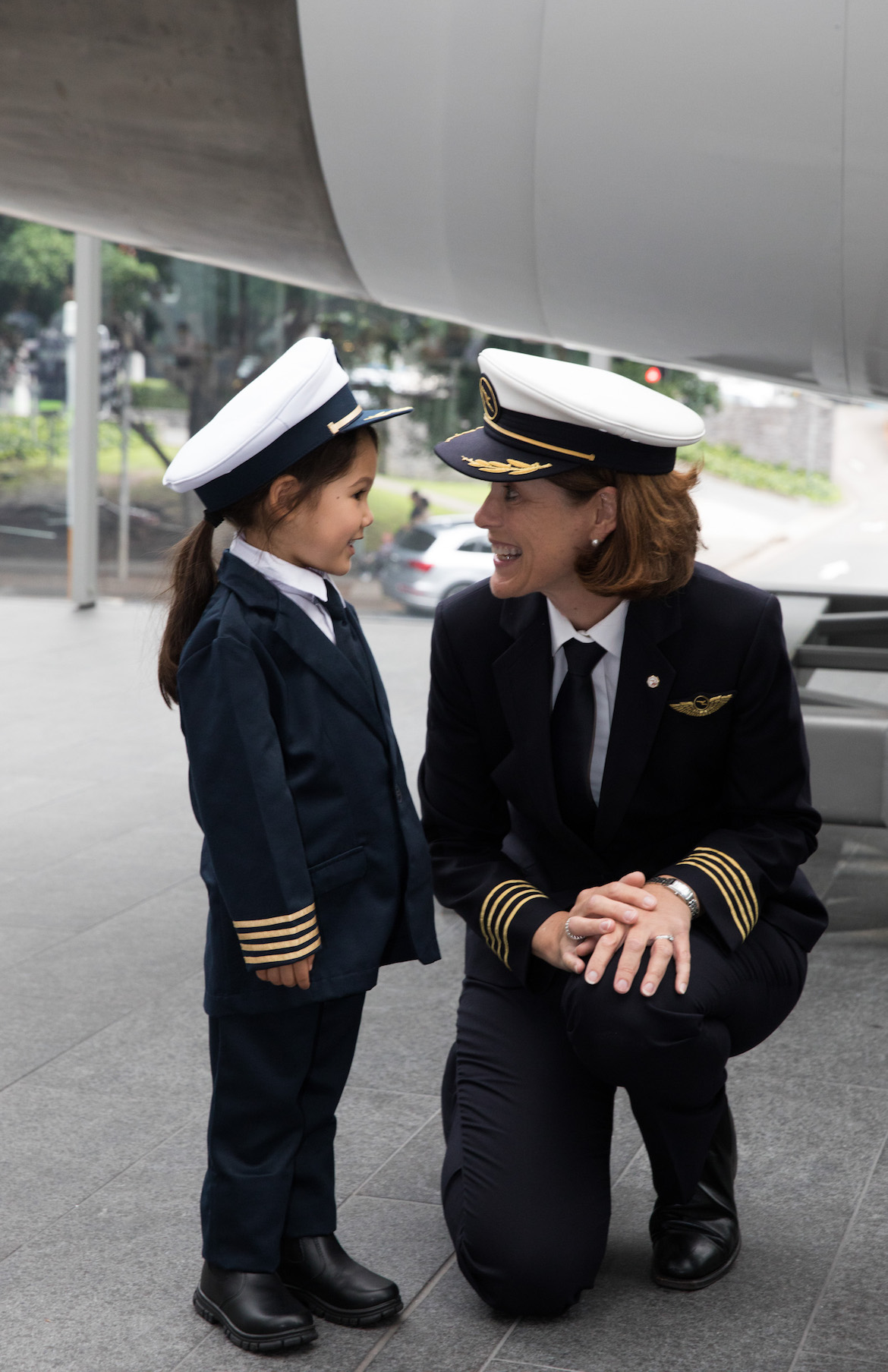To mark International Women’s Day on Friday, March 9 2019, this week’s Throwback Thursday is from the May 2018 edition of Australian Aviation, where John Walton looked at efforts to attract more women into the aviation industry.
Commercial aviation is staring down the end of a demographics barrel. It’s rare that Boeing and Airbus or Qantas and Virgin Australia agree on much, but the two global airframers agree that more than a million pilots and maintenance technicians will need to be trained in the next twenty years, and Australia’s largest airline groups are spending time, senior level focus and money on ensuring they have the resources to meet soaring demand.
The problem is, the industry is currently missing out on 50 per cent of the global talent pool: women. Fewer than five percent of pilots are women — Qantas says three per cent, worldwide — and the proportion of maintenance engineers is smaller still. Commercial aviation, and particularly the technical world of the flightdeck and maintenance hangar, is disproportionally dominated by men, although airlines, airframers, suppliers and the rest of the industry are, largely, looking to attract more women into the business.
“Between now and 2036, the aviation industry will need to supply more than 2 million new commercial airline pilots, maintenance technicians, and cabin crew,” Boeing’s 2017 Pilot and Technician Outlook forecast stated, noting that of those numbers 637,000 will be commercial airline pilots and 648,000 will be maintenance technicians.
“Over the next 20 years,” Boeing noted, “the Asia Pacific region will lead the worldwide growth in demand for pilots, with a requirement for 253,000 new pilots. North America will require 117,000, Europe 106,000, the Middle East 63,000, Latin America 52,000, Africa 24,000 and CIS/Russia 22,000.”
With more mobility than ever for technical and flightdeck expertise, ensuring more women in aviation isn’t just the decent thing to do. It’s a firm business case that companies with a grip on their future are taking very seriously. Moreover, diverse workforces that reflect the world around them are, simply, better at achieving the objectives their companies set out, and creating them is hard: it’s not just a letter-of-the-law, box-ticking exercise.
As an English-speaking country in the Asia Pacific region, with English the language of international aviation, Australia and Australians have a home-ground advantage. But that also means that Australian pilots, engineers and other technical experts are in demand internationally.
The Qantas Group Pilot Academy shows how seriously Australia’s largest airline is taking the potential shortage. Late last year, chief executive Alan Joyce said at a Qantas-hosted Male Champions of Change Leaders’ Forum in Sydney, “next year, when we need to hire more than 300 pilots across the Group, I want us to up the ante with our female pilot intake.”
“Qantas Group commits to a 20 per cent intake of women in our 2018 cadet program and we will double that number over the next decade to reach gender parity, at intake, through our Nancy Bird Walton Initiative. This initiative will support girls and women on a merit-based path to a career as a Qantas Group pilot.
“We’ll target STEM [science, technology, engineering and mathematics] in schools, flying schools and cadet programs to achieve our aspiration. It is going to take a concerted effort but it’s time for a moonshot vision for gender equality.”
Chris Smith, general manager of operations for Boeing Defence Australia, is equally clear that action is needed.
“Boeing Australia recognises strong leadership is required to increase the number of women within the Australian aerospace industry. Boeing Australia has appointed dedicated resources to review and implement diversity and inclusion practices nationwide, resulting in a Diversity Action Plan endorsed and supported by the Boeing Australia Holdings board of directors.”
“Aligned with Boeing’s global Diversity & Inclusion strategy, the Boeing Australia goal is to increase the number of women in leadership and technical roles and across the business overall,” Smith tells Australian Aviation.
This strategic view is critical for any airline, airframer or other company working in commercial aviation: businesses are stronger, more customer-focused, more productive and better places to work when they reflect the society they operate in, the staff they employ, and the markets they serve.

Virgin Australia sets and achieves goals, seeks to do more
“Attracting women to what is typically male-dominated areas, and showcasing that there is excellent career opportunities and progression,” is the greatest challenge facing Australia’s aviation industry as it seeks to meet the demand for the future years, Lucinda Gemmell, Virgin Australia’s group executive for people, tells Australian Aviation.
Gemmell’s colleague, Virgin Australia head of maintenance Cleo Alexander, concurs.
“The greatest challenge in engineering is promoting the role and convincing women that it’s a rewarding career, and making more women aware of the role. Engineering, when it comes to aviation, is shift-work, which can be challenging especially when trying to balance work and family. However, Virgin Australia promotes a flexible workplace to make it work for everyone.”
“We recognise that, typically,” Gemmell says, “the technical areas of aviation are male-dominated, but we are working hard to challenge that and improve gender imbalances in these areas. We have a number of initiatives in place across our organisation to attract and retain the right talent, irrespective of their gender.”
Those include a pilot cadetship program, which creates a direct pathway into the industry, and also lines up a job with Virgin Australia after successfully completing the course.
The airline works with local initiatives, like the Aerospace Gateway to Industry Schools program, which boosts the growth and development of a capable workforce base for Australia’s aviation industry. Students regularly tour the Brisbane operations control centre and Virgin Australia’s maintenance hangar to encourage them to join the industry.
“The Network Operations team supports the crewing and running of the airline on the lead up to, and day of operations,” Gemmell says.
“Over the past three years the team has significantly increased its female representation. Now, it’s not uncommon to see a near all-female team running Operations Control and Crew Control. The female representation increase in this area was driven through recruitment and significant female participation in the foundations leadership course through our partnership with University of Queensland Business School, Executive Education.”

(Virgin Australia)
More widely, Virgin Australia is a participant in industry groups like Women in Aviation/Aerospace Australia, discussing gender diversity and seeking to increase women’s participation in aerospace and aviation in Australia, as well as providing a network for women to network within the industry, attract future generations into aviation and aerospace, and to promote excellence within their careers.
“We continue to explore further opportunities through partnerships and memberships of this nature to support a long-term strategy to encourage people to consider a career as a pilot,” Gemmell says.
“As with all of our attraction strategies, this will be underpinned with a desire to have representation from diverse groups.”
Across the Virgin Australia Group, the airline has set itself several objectives, including to maintain the proportion of women in what it calls CEO-1 and CEO-2 grades (direct reports to the Group CEO, and their direct reports, including Tigerair Australia) above 36 per cent.
The Group’s chairman is a woman, Elizabeth Bryan, as is newly-appointed chief executive officer for Tigerair Australia Merren McArthur, and currently 50 per cent of the executive team reporting to the CEO are women. It is also carrying out an ongoing review of gender pay gaps.
“We are focused on developing female leaders of the future and to assist with this we have dedicated talent processes to identify, develop and plan for movements of high potential women into senior management,” Gemmell says.
“We have run a number of targeted development programs for women, including the Chief Executive Women program we run, where we sponsor a small group of women each year in a mentoring course. The inaugural course ran last year, which was a great success, and we look forward to continuing this program again this year.”
Virgin Australia is also working on the “pipeline issues” of getting more women into technical education and supporting them during and after their studies.
“Last year, Virgin Australia and Campus Travel opened up applications for Travel Grant: Recognising women in STEM. We received over 1,000 applications for the $6,000 grant. In December 2017, the successful recipient was a Queensland University of Technology PhD student working in STEM who says she will use the money to further her research and work with a leader in her field in London,” Gemmell says.
Boeing highlights STEM education and the pipeline
Boeing Australia, too, is keen to increase the number of talented women in its business.
“Boeing Australia is a key sponsor and keen supporter of external organisations nurturing young women in aerospace such as the Power of Engineering group and Women in Aerospace/Aviation Australia. The company has taken a deliberate approach to foster relationships with our Australian university partners and schools with a focus on STEM,” Chris Smith, general manager of operations for Boeing Defence Australia, tells Australian Aviation.
“This has included dedicated scholarships for young female and male engineers and technical students, and student internship programs to provide real-world experience in aerospace jobs and grow the talent pipeline,” Smith says.
“In recent years at Boeing Defence Australia, a targeted approach has resulted in a balanced intake of talented females and males through its graduate and intern programs. Boeing Australia also sees mentoring relationships between senior leaders and future female leaders as critical to retaining top female talent.”
The end goal: raising the number of women in technical roles, leadership positions, and throughout the company.
“Elements of the strategy include proposed unconscious bias training for leaders, a recruitment review of hiring and retention practices to ensure a talent pool of qualified women and men, the introduction of a Boeing Women in Leadership program, nationwide International Women’s Day events, and establishment of a gender working group to address specific tactics in the areas of leadership, culture and talent,” Smith says.
VIDEO: Boeing engineers read responses from universities to letters sent in 1919 asking if any female engineering students had ever been enrolled, from the company’s YouTube channel.
But Rex says initiatives are “an insult”
Regional airlines are a key part of the commercial aviation ecosystem, and face particular challenges in training and retention of pilots, engineers and key technical staff.
But responding to questions from Australian Aviation about making aviation a more attractive career for women, gender imbalance, and pipeline problems a Rex spokesperson would say only: “Each position in the Rex group is filled on the basis of merit. To have special affirmative initiatives to promote the number of women in the workforce is reverse discrimination and an insult to women.”
Regional Express has no women on its board of directors nor on its senior management team.

Qantas is on an upward climb, seeks to increase trajectory
Qantas is one of the few aviation companies willing to speak about its gender balance statistics. With a global women pilot proportion of just three per cent, even Qantas’s existing work has only achieved a rise of 15 per cent in its domestic and international pilot pipeline, where women now make up 18 per cent.
The current state of Qantas: “overall, across all of our airlines, including Jetstar and QantasLink, we are at just over five per cent female pilots – around 190 women compared to more than 3,300 men,” Alan Joyce said in November, shortly before the departure of erstwhile Jetstar CEO Jayne Hrdlicka from the aviation industry.
“We can’t dismiss this gap by saying that family commitments make a career as a pilot unsuitable for a woman. Not when we know that our cabin crew have similar rosters and 68 per cent of our flight attendants are women. The increases are certainly a move in the right direction and proof of the power of knowing your numbers and challenging your teams to do more,” Joyce admits.
“But until we identify and accept the points of weakness in our systems and processes, female pilots will remain in the minority. We have to look deeper into the issue and really understand the barriers and entrenched bias in a system so we can forge a better way forward. We need to ask why it exists and, importantly, be prepared to hear, accept, and act on the answer.”

Regarding the question of gender equality, Joyce says, “At Qantas we have asked the question and have made some gains. We’ve done it by identifying and removing the barriers to participation and making our workplace more inclusive – a place where women can and do thrive. We have relentlessly pursued new thinking and revisited the concept of unconscious bias.”
Notably, Joyce highlights that “the change we’ve made to our recruitment policy and the governance around it is also having a significant impact. Every month we measure our application rates, our shortlists and the gender balance on interview panels. Again, it’s about knowing the numbers. And we take heart from our wins – one third of the Qantas board are now women; four out of nine of my leadership team are women; 43 per cent of our overall workforce are women; and 50 per cent of our graduates are women. We are also proud of the fact that we reached – ahead of time – our target for women to make up 35 per cent of our senior management team.”
“We also achieved gender pay parity at senior management level and, for the first year, our external recruits into senior roles have been more than 50 per cent women,” Joyce says. “What was particularly pleasing with that achievement were the gains in technology roles. In our most recent wave of recruitment in IT, we saw over 62 per cent of offers made to women.”
“We are doing things differently to attract and offer women roles and we are doing better. But, I’ll put my hand up and say, for all the gains I’ve just listed, they could have – and should have – been better,” Joyce admits.
“We did not apply enough rigour to processes for promotion into senior roles and, as a result, we missed a golden opportunity to surpass the target we had set ourselves. We also know, through interviews and surveys, that we need to be relentless about offering flexibility. We should not be losing talent and knowledge because of inflexibility.”
“We’re prepared to set goals and expectations right across our organisation. We’ll continue to challenge our employees’ ideas of gendered roles and leadership and keep breaking through the embedded barriers in our systems,” Joyce says. “There is no question that we are doing better, but we need to work together to get this change happening faster.”
https://www.facebook.com/JetstarAustralia/videos/435089823698103/
VIDEO: Jetstar asks on its Facebook page, “When you take your seat on a plane, who do you picture sitting in the flight deck?”
This story first appeared in the May 2018 edition of Australian Aviation. To reach more stories from the printed magazine, become a member here.










